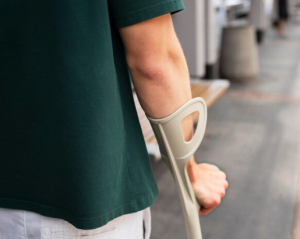Whether you’re recovering from surgery, a fractured bone, or dealing with a temporary mobility issue, you’ve probably been recommended to use crutches! Using them can help you maintain independence while also reducing the amount of stress on your body. In this guide, we’ll explore the basics of using crutches to get around.
How do I choose the right pair?
Firstly, you need to have the right pair for your needs. There are various types of crutches, including axillary, forearm, and platform. Usually, the most used are axillary (standard) crutches but they require good upper body strength and endurance. If you are unsure consult with your healthcare provider to determine which type is best suited for you.
How do I size them?
In order for crutches to be effective and comfortable, they must be the correct size for you. Luckily, most types are adjustable now. The top of the crutch should be about 1-2 inches below your armpits, and your elbows should be slightly bent when holding the handgrips. Your weight should be distributed evenly between your hands and wrists, and this is where you should be supporting most of your weight. Avoid putting too much pressure on your armpits, as this will lead to discomfort and pain.
How do I walk with crutches?
1. Correct Posture: You should be able to stand up straight with your weight evenly distributed between both legs if your crutches are sized properly. Hold the handgrips firmly and keep your elbows slightly bent.
2. Taking Steps: This step will look slightly different depending on whether you are allowed to put weight on your injured leg. There are many different types of patterns you can use to walk but we will describe the most common.
- Unable to weightbear: Your injured leg should be held off the floor the entire time. This is known as the tripod position because you will have 3 points of contact, both crutches and your good leg. Firstly, move your crutches forwards about a step’s length. Then, with your weight on your hands/crutches, lift your good leg forward. Finally, repeat these steps at a comfortable speed, alternating between moving the crutches then the good leg.
- Able to weightbear: Your crutches will move forward first, closely followed by the injured leg. As you transfer weight onto your injured side, you will use your arms/crutches to support and take some weight off of it. Finally, the good leg will move forward. Again, repeat these steps at a comfortable speed.
3. Practice: Moving around with crutches takes time to learn. Expect to be moving slowly at first, but with enough practice it will become second nature.
Can I go up and down stairs with crutches?
1. Going up: Hold your crutch in one hand while gripping the handrail with the other. Step up with your good leg first, then bring the crutch up to meet it on the same step. Finally, bring the injured leg up the step.
2. Going down: Face the stairs and hold onto the handrail. Lower the injured leg and the crutch at the same time onto the next step down. Next, using the crutch and handrail for support, lower your good leg down.
Other considerations:
- Home modifications: Arrange your living space to minimize obstacles and allow an easy path for yourself. Clear clutter and create wider pathways to facilitate smooth movement and minimize tripping and fal hazards.
- Assistance devices: Consider using assistive devices like a backpack or a crutch caddy to carry items. This will allow you to maintain your balance while still carrying necessities, as both your arms will be in use.
If you need help picking out a pair of crutches and learning how to use them, or need physical rehabilitation after your injury, look for PhysioNow! We have many experienced physiotherapists at our facilities across the GTA from Burloak to Long Branch. Book with PhysioNow today for your first assessment and treatment!






Leave a Reply